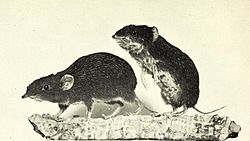| Shrew gymnure | |
|---|---|
 | |
| Scientific classification | |
| Domain: | Eukaryota |
| Kingdom: | Animalia |
| Phylum: | Chordata |
| Class: | Mammalia |
| Order: | Eulipotyphla |
| Family: | Erinaceidae |
| Subfamily: | Galericinae |
| Genus: | Neotetracus |
| Species: | N. sinensis |
| Binomial name | |
| Neotetracus sinensis Trouessart, 1909 | |
 | |
| Shrew gymnure range | |
The shrew gymnure, or shrew hedgehog (Neotetracus sinensis), is a species of mammal in the family Erinaceidae and is the only extant species in the genus Neotetracus. It is found in China, Myanmar, and Vietnam.
